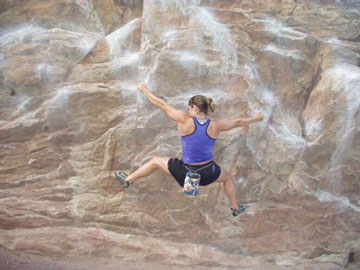 by Ned Rozell May 19, 2005
A decade ago, Johnston became the youngest female to reach the summit of Denali when at age 12 she and her mother Jennifer Johnston climbed the mountain. Now 22, Johnston is a senior at Dartmouth College and a mountain guide in the Tetons during the summer. This May she'll present at a conference the results of her unique undergraduate project a 400-mile ski traverse in northwest Alaska during which she scooped up snow samples to test for pollutants.
In March of 2003 Johnston traveled to Kotzebue with snow-sampling equipment, a few friends, and "shorty" skis that were good for both classic and skating techniques. Dartmouth student Eben Sargent and her mother Jennifer Johnston joined her on skis, Mellon Shea of Anchorage mushed a team of dogs, and Tim Remick and Wayne Oxford provided snowmachine support as they traveled a network of village trails from Kotzebue towards Kobuk and back. Along the way they dug nine snow pits with the help of kids from village schools and gathered 100 snow samples to send back to Dartmouth and the Cold Regions Research and Engineering Laboratory in Hanover, New Hampshire. Johnston was interested in sampling the purity of northwest Alaska snow because a good friend from the area told her of an apparently high incidence of cancer among her family members and poor water quality there. Winter storms in the area mostly blow in from either the north or the south, Johnston said, and the northern storm track might bring pollutants from industrialized areas of northern Russia. During the two-week adventure, the Johnstons and Sargent often skied 30 to 40 miles on slow, below-zero snow, then spent four hours digging a snow pit, in which Johnston measured snow temperature, depth, density, ice layers, and different types of snow grains. At night, some of the party stayed in a wall tent heated by a small stove, while the Johnstons and Sargent stayed in a smaller, unheated tent. The adventurous nature of the trip helped break up the strict regimen of the science, and the caravan of skis, dogs, and snowmachines made their visit to villages more fun than if they'd just dropped in by airplane, Johnston said. During the trip, the group weathered a snowstorm that Johnston was later able to research using U.S. Navy weather maps. The storm originated in the northwest Arctic, possibly bringing a parcel of air to Alaska from Russia. In two of the five sites she measured after the storm, she saw elevated levels of heavy metals in the snow. In about 100 snow samples, which she melted and brought back to Dartmouth in plastic vials, she found evidence of six metals cobalt, cadmium, arsenic, chromium, barium and strontium. Since there are no obvious sources of those metals in northwest Alaska, Johnston wagers they probably came from other industrial areas at the top of the world. While the levels of heavy metals in the snow were low, they once again show that pollutants travel everywhere on Earth, no matter how remote. Johnston is still teasing apart the snow data for her presentation at the American Geophysical Union meeting in New Orleans this May, but she said she'd really like to go back to the northwest Alaska village of Kiana where she might have the opportunity to teach and sample the snow as it hits the ground in fall, winter, and spring. "You'd get much more conclusive results if you were on-site," she said. The youngest woman ever to climb North America's tallest mountain has other options too. Johnston graduates from Dartmouth in June, and has to weigh the Kiana opportunity against a few other possibilities, including graduate school at UAF for geophysics or a job as a mountaineering guide in Chile.
This column is provided as a public service by the Geophysical Institute, University of Alaska Fairbanks, in cooperation with the UAF research community. Ned Rozell [ nrozell@gi.alaska.edu ] is a science writer at the institute. Publish A Letter on SitNews Read Letters/Opinions Submit A Letter to the Editor
|
||
